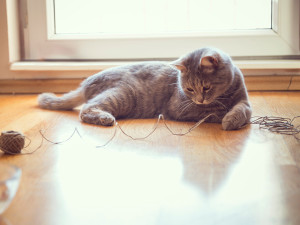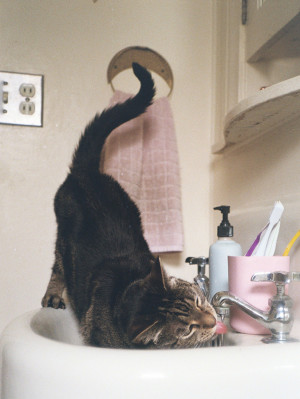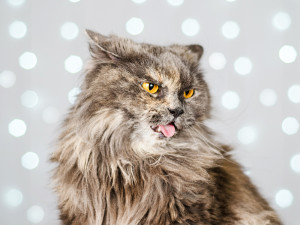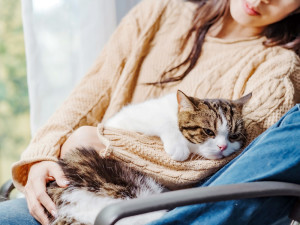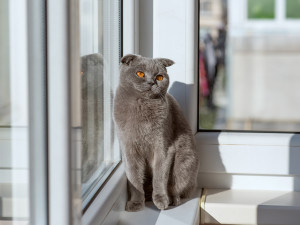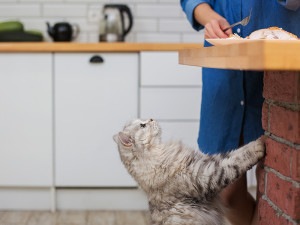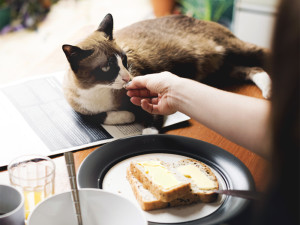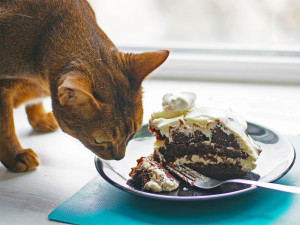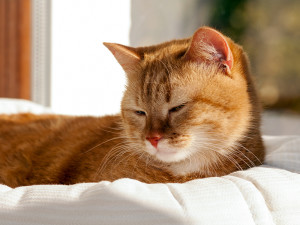Pancreatitis in Cats: Symptoms, Causes, and Treatments
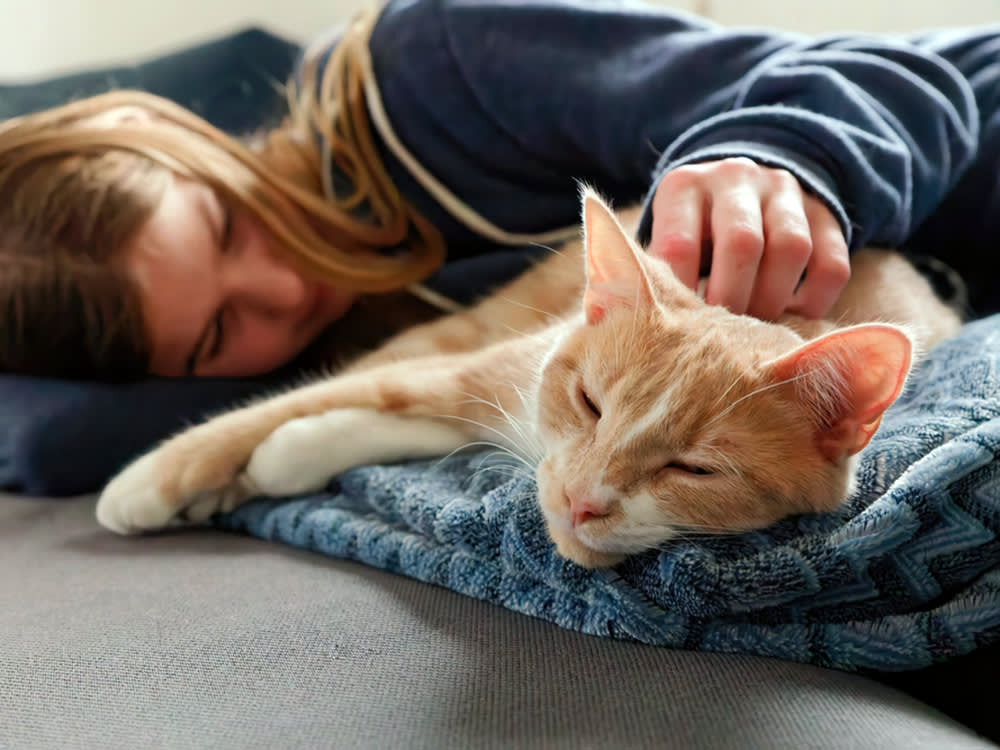
Share Article
In This Article:
Causes of Pancreatitis in Cats Symptoms of Feline Pancreatitis Diagnosing Pancreatitis Pancreatitis Treatment Goals Acute vs. Chronic Pancreatitis Recovery and Prognosis Factors
Pancreatitis in cats occurs when digestive enzymes normally released to help break down food start to inflame the pancreas itself. Most episodes of pancreatitis in cats do not have a known cause. Common symptoms include lethargy, appetite loss, dehydration, and vomiting.
Causes of pancreatitis in cats
What causes pancreatitis in cats remains a mystery in most cases. About 95 percent of episodes of pancreatitis in cats are idiopathic, meaning that there’s no known cause. There are a few things known to trigger pancreatitis in cats, such as:
Certain parasitic infections, like toxoplasmosis
Viral infections (herpesvirus, calicivirus, feline coronavirus)
Cancer
Anesthesia and surgical handling of the pancreas
Trauma to the pancreas (falling from high buildings, being bitten by a dog or hit by a car)
These causes are inconsistent, though. For example, many cats get infected with herpesvirus without ever showing signs of pancreatitis. A fatty diet or meal is a common trigger for pancreatitis in dogs, but cats seem to tolerate fat better and do not seem to have pancreatitis triggered by increased fat in their diet.

Pancreatitis is associated with several common diseases in cats, but sussing out how these conditions impact the pancreas (and vice versa) is challenging. Some common cat diseases that are seen with pancreatitis include:
Diabetes mellitus
Inflammatory bowel disease (IBD)
Gallbladder disease
Immune-mediated hemolytic anemia
These conditions can all make pancreatitis more challenging to treat and pose additional dangers to cats with pancreatitis.
Can stress cause pancreatitis in cats?
Anxious cats may eat less and have higher levels of stress hormones, which could lead to decreased blood flow to the pancreas and set the stage for development of pancreatitis. No evidence has been found linking stress directly to pancreatitis in cats though. This is not something that has been studied extensively, and trying to figure out if something is stressing a cat outopens in new tab enough to cause illness can be a challenge.
Symptoms of feline pancreatitis
Cats are great at not making their illnesses obvious until they’re really sick, so it’s important to watch for any changes in your cat’s behavior or routine. The signs of pancreatitis in cats, in order of frequency, include:
Lethargy
Dehydration
Low body temperature
Vomiting
Weight loss
Diarrhea
Yellowing of gums, skin or whites of eyes
Abdominal pain
Fever
Unlike dogs, only one third to half of cats with pancreatitis will vomi t, and sometimes they only vomit once. Many of these signs are non-specific and are seen with numerous diseases in cats. If your cat isn’t quite right, it’s best to get them checked out by your veterinarian. There’s a direct correlation between the time from onset of symptoms to presentation to a vet’s office and the successful treatment of pancreatitis in cats.
How is feline pancreatitis diagnosed?
Pancreatitis is notoriously tricky to diagnose with certainty, and suspicion of pancreatitis is usually based on the combination of testing and symptoms. Your vet will examine your cat to look for evidence of dehydration, abdominal pain, and other symptoms associated with pancreatitis. Based on your cat’s history and examination, they may recommend diagnostic tests to help establish if your cat is suffering from pancreatitis or another condition.
Blood work can help look for diseases like diabetes that can be seen alongside pancreatitis. A relatively recently introduced test can look for a specific enzyme called feline pancreatic lipase (fPL) that is very commonly elevated when a cat has pancreatitis. A positive fPL test significantly raises the suspicion of pancreatitis (but is not definitive), while a negative test makes pancreatitis very unlikely as the cause of a cat’s symptoms.
Abdominal radiographs aren’t super helpful in diagnosing pancreatitis in cats, but ultrasound is commonly used to image the pancreas and surrounding organs to look for changes. A vet experienced with ultrasound can also look for problems in the gallbladder, intestines, and liver that can be associated with pancreatitis, making this a useful test for many sick cats.
How is feline pancreatitis treated?
The treatment for pancreatitis will vary based on the severity of the disease. Mildly affected cats may only need some fluids under their skin and anti-nausea medication. Cats showing signs of more severe pancreatitis like dehydration, low body temperature, low blood pressure, or abdominal pain may need hospital treatment to get better.
The goals for treatment of pancreatitis are to:
Restore hydration.
This is usually accomplished by administering IV fluids. Giving a balanced electrolyte solution can help to make up for fluid losses from decreased intake or vomiting. Improving hydration helps to restore blood flow to the pancreas, allowing it to heal.
Control nausea and begin feeding.
Anti-nausea medications are a mainstay of pancreatitis treatment. Using one or more agents to help settle a cat’s stomach allows them to begin taking in food again. Early restoration of nutrition helps to minimize further damage to the pancreas and limits the worsening of systemic disease. Getting food back into the intestines is so important to survival that many cats with pancreatitis will be treated with appetite stimulants and may even get a feeding tube.
Feeding tubes can either be placed in the nose and go down into the stomach (which only requires sedation but is more temporary) or directly into the esophagus through the neck (which requires anesthesia but can be used longer). Cats unwilling to eat on their own can be fed a liquid diet through these tubes to provide the nutrition they need to recover.
Treat any possible causes or associated conditions.
Part of pancreatitis therapy is finding and treating other conditions that could cause injury to the pancreas. This means that other diseases like diabetes, gallbladder inflammation, or IBD need to be identified and kept under control. The presence of other conditions can make treating pancreatitis more complicated and lengthy.
Make sure pain is controlled.
Cats are often stoic and do not show the same signs of pain as other pets. Pancreatitis is a painful condition, and it should be assumed that cats with pancreatic inflammation are feeling some discomfort, even if they’re not super obvious about it. Treatment with appropriate pain medications, like opioids, can make sure cats with pancreatitis are staying comfortable. Getting pain under control can also improve appetite and overall attitude.
Acute vs. chronic pancreatitis
As veterinarians have recognized pancreatitis in cats more frequently, it’s become evident that there are two forms of the disease. Acute pancreatitis is the one that is more commonly thought of as causing noticeable symptoms and severe illness. While the exact trigger is unknown, it seems to be caused by early activation of enzymes within the pancreas.
One of the major functions of the pancreas is to produce enzymes that help to break down food in the intestines. These enzymes are stored in the pancreas in an inactive form, and the body keeps them isolated in crypts separate from the blood supply and tissues of the pancreas. The inactive enzymes are normally released into pancreatic ducts that empty into the duodenum, the first part of the intestines. Another enzyme produced by the lining of the duodenum activates the pancreatic enzymes so they can begin digesting food in the intestines.
In acute pancreatitis in cats, these enzymes are somehow activated while they’re still in the pancreas. This causes the enzymes to begin digesting pancreatic tissue, causing inflammation, which can trigger additional enzyme leakage. This cascade can be so severe that parts of the pancreas begin dying off.
In chronic pancreatitis in cats, there is fibrosis (scarring) of the pancreas due to chronic, low-level inflammation. This can be triggered by an episode of acute pancreatitis or happen on its own. Cats with chronic pancreatitis may have waxing-waning decreases in appetite and issues with digestion related to a lack of pancreatic enzymes.
Recovery and prognosis factors
Rehydration and restoration of nutrition are the keys to treating pancreatitis in cats. Working with your vet to get your cat to feel better will help your cat recover from this illness. Some cats will make a complete recovery while in the hospital, but others will need some supportive care as they continue to heal at home. Your veterinarian can help guide you on how to treat pancreatitis in cats at home and how to manage medications, feeding tubes, or at-home diets.
The prognosis for cats with pancreatitis varies a good bit. The amount of inflammation in the pancreas, the severity of symptoms, and the presence of other systemic diseases like diabetes all affect how likely a cat is to recover from a bout of pancreatitis. Studies have shown a wide range of outcomes from pancreatitis, with 9 to 41 percent of cats dying from the disease. Findings like low blood calcium, low blood sugar, and high kidney values have been associated with worse outcomes in cats.
Recognizing pancreatitis early and initiating treatment before signs are severe is the best way to prevent your cat from the worst effects of pancreatitis. If your cat seems to be feeling sick, get them to the vet sooner rather than later. Prompt intervention can make pancreatitis less severe and get your cat back to living their best life.
FAQs (People also ask):
Can stress cause pancreatitis in cats?
Pancreatitis has not been associated with stress in cats. While some of the side effects of stress could theoretically affect the pancreas, the link between the two has not been established. Enriching your cat’s environment can help to reduce stress.
What is the mortality rate for cats with pancreatitis?
The mortality rate for cats with pancreatitis is nine to 41 percent. This wide range is affected by the severity of symptoms, time to start therapy, and concurrent diseases. Cats with mild to moderate disease usually respond well to treatment.
What foods cause pancreatitis in cats?
Pancreatitis in cats does not seem to be triggered by high-fat diets or foods like it is in dogs. The trigger for pancreatitis in cats is often a mystery, with 95 percent of cases having no identifiable cause.
References:
ACVIM Consensus Statement on Pancreatitis in Catsopens in new tab
Diagnosis of feline pancreatitis with SNAP fPL and Spec fPLopens in new tab

Dr. Bartley Harrison, DVM
Dr. Bartley Harrison is a veterinarian with more than 19 years of experience. He has treated a variety of species in emergency and speciality practices for both large and small animals. His primary interests as a vet are emergency medicine and critical care.
Related articles
![Person with short hair putting water bowl on floor for cat]()
How to Get a Cat to Drink Water
Their desert-dwelling roots might resist hydration, but these tricks can help.
![Cat asking for human food from counter]()
What Can Cats Eat Besides Cat Food?
Good news for your begging cat: Some of your favorite snacks are safe to share.
![Woman feeding her cat buttered toast for breakfast.]()
Can Cats Eat Butter?
Butter isn’t toxic to your cat—but despite what they tell you, they really shouldn’t eat it.
![Cat eating out of metal bowl]()
Top 10 Foods That Are Toxic to Cats
Sharing isn’t always caring. Keep your cat safe by keeping these human snack staples to yourself.
Can Cats Eat Chocolate?
No, no, no. Absolutely not. Here’s why.
![Red cat with squinted eyes laying in a basket closeup]()
6 Ways Your Cat Could Tell You They Are in Pain
Here are all the way your kitty is trying to tell you they’re hurting.
